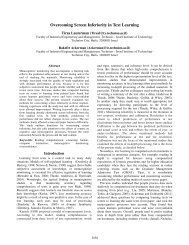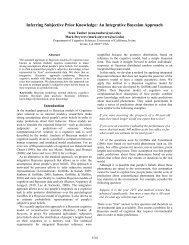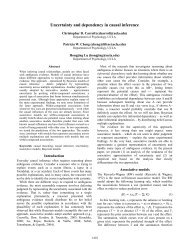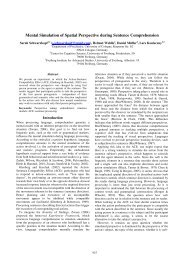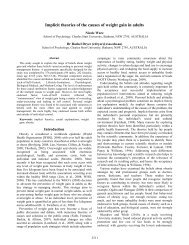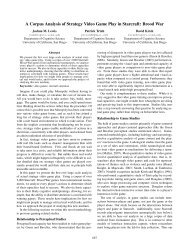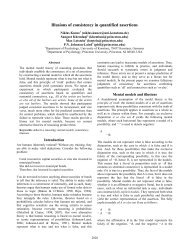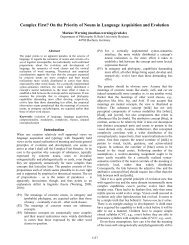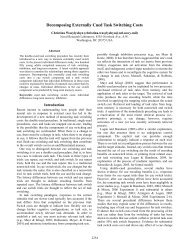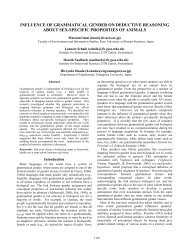Systematic Sound-Meaning Associations in Novel and Existing Words
Systematic Sound-Meaning Associations in Novel and Existing Words
Systematic Sound-Meaning Associations in Novel and Existing Words
You also want an ePaper? Increase the reach of your titles
YUMPU automatically turns print PDFs into web optimized ePapers that Google loves.
also judged as be<strong>in</strong>g less powerful than monosyllabic<br />
stimuli with a high (front) vowel. This f<strong>in</strong>d<strong>in</strong>g <strong>in</strong>dicates that<br />
sound symbolism that arises due to vowel-<strong>in</strong>tr<strong>in</strong>sic<br />
fundamental frequency is not bound to a s<strong>in</strong>gle phoneme but<br />
may be the result of comb<strong>in</strong><strong>in</strong>g the acoustic values for<br />
sequences of syllables.<br />
Experiment 3<br />
In the third experiment, we explored sound-symbolic<br />
<strong>in</strong>terpretations of tones <strong>in</strong> a tonal language (M<strong>and</strong>ar<strong>in</strong><br />
Ch<strong>in</strong>ese). In spite of the long tradition of phonetic <strong>and</strong><br />
phonological research <strong>in</strong>to tone perception <strong>and</strong> use <strong>in</strong> tonal<br />
languages, no experimental studies have laid an explicit l<strong>in</strong>k<br />
between the Frequency Code <strong>and</strong> lexical tones (for a general<br />
overview, see Lapolla, 1994).<br />
Participants <strong>and</strong> Design<br />
N<strong>in</strong>ety-six graduate <strong>and</strong> undergraduate Ch<strong>in</strong>ese students (39<br />
male) from a university <strong>in</strong> Beij<strong>in</strong>g participated <strong>in</strong> the study,<br />
11 participants were excluded from the analysis due to<br />
<strong>in</strong>complete data caused by server problems. The study was<br />
conducted <strong>in</strong> M<strong>and</strong>ar<strong>in</strong> Ch<strong>in</strong>ese <strong>and</strong> had a 2 x 4 design<br />
mixed with<strong>in</strong>-between participant design. The with<strong>in</strong>participant<br />
variable was Tone (Tone 1 <strong>in</strong> high pitch height<br />
(H) - Level, Tone 2 <strong>in</strong> half-high pitch height (LH) - Ris<strong>in</strong>g,<br />
Tone 3 <strong>in</strong> half-low pitch height (L(H)) – Low-Ris<strong>in</strong>g, <strong>and</strong><br />
Tone 4 <strong>in</strong> low pitch-height (HL) - Fall<strong>in</strong>g; Gussenhoven,<br />
2004; Wiedenhof, 2004). The between-participant variable<br />
was the writ<strong>in</strong>g system (Ch<strong>in</strong>ese characters or P<strong>in</strong>y<strong>in</strong>);<br />
participants were r<strong>and</strong>omly divided <strong>in</strong>to one of the two<br />
conditions (45 <strong>in</strong> the character-written group <strong>and</strong> 40 <strong>in</strong> the<br />
P<strong>in</strong>y<strong>in</strong>-written group).<br />
Material<br />
Sixteen non-existent br<strong>and</strong> names (pseudowords) were<br />
written <strong>in</strong> matched Ch<strong>in</strong>ese characters <strong>and</strong> <strong>in</strong> P<strong>in</strong>y<strong>in</strong> with<br />
four different tones (e.g., lū, lú, lǔ <strong>and</strong> lù). A pretest<br />
conducted with the P<strong>in</strong>y<strong>in</strong> transcriptions showed that<br />
Ch<strong>in</strong>ese readers (same population, different group than the<br />
participant group) did not have any mean<strong>in</strong>gful associations<br />
with the stimuli outside of the context of the experiment.<br />
Procedure <strong>and</strong> Instrumentation<br />
Participants evaluated the visually presented stimuli on a 7po<strong>in</strong>t<br />
scale us<strong>in</strong>g the anchors “not powerful at all” (1) <strong>and</strong><br />
“very powerful” (7). The study was conducted onl<strong>in</strong>e with<br />
help of the Qualtrics platform.<br />
Results<br />
There was a significant ma<strong>in</strong> effect of the type of tone on<br />
the average perceived power of br<strong>and</strong> names, F(1.88,<br />
156.71) = 79.297, p < .001, ηp 2 = .49, with degrees of<br />
freedom corrected us<strong>in</strong>g Huynh-Feldt estimates of<br />
sphericity. Post-hoc comparisons revealed that the Tone 4<br />
(Fall<strong>in</strong>g) was more powerful than the other three Tones.<br />
Tone 2 (Ris<strong>in</strong>g) <strong>and</strong> Tone 3 (Low-Ris<strong>in</strong>g) were more<br />
powerful than Tone 1 (Level/High); the perception of Tone 2<br />
1148<br />
was not different from the perception of Tone 3, see Fig. 1.<br />
The writ<strong>in</strong>g system used for the presentation of stimuli did<br />
not have a significant effect.<br />
Figure 1: Perception of Ch<strong>in</strong>ese lexical tones <strong>in</strong> novel br<strong>and</strong><br />
names.<br />
Discussion<br />
The results of the experiment show that the lexical tones <strong>in</strong><br />
M<strong>and</strong>ar<strong>in</strong> Ch<strong>in</strong>ese are <strong>in</strong>terpreted <strong>in</strong> a similar way as<br />
segmental <strong>and</strong> suprasegmental pitch (fundamental<br />
frequency) <strong>in</strong> non-tonal languages. Along the l<strong>in</strong>es predicted<br />
by the Frequency Code, high (level) <strong>and</strong> ris<strong>in</strong>g tones are<br />
associated with less powerful br<strong>and</strong> names than fall<strong>in</strong>g<br />
tones.<br />
Experiment 4<br />
In the fourth experiment, we identified another <strong>in</strong>tr<strong>in</strong>sic<br />
acoustic property of vowels, namely <strong>in</strong>tensity, as a feature<br />
that might play a role <strong>in</strong> cross-modal relationships. Given<br />
that the two acoustic values often correlate, it could be that<br />
at least some of the sound-symbolic effects discussed <strong>in</strong> the<br />
literature are caused by perceptions of <strong>in</strong>tensity. Therefore,<br />
we were <strong>in</strong>terested <strong>in</strong> a possible <strong>in</strong>terplay of the two<br />
acoustic properties.<br />
Participants <strong>and</strong> Design<br />
The participants were 146 native Dutch speakers (84 male,<br />
Mage = 40.39, SD = 13.5) who took part <strong>in</strong> the experiment<br />
on a voluntary basis. The experiment had a 2 x 2 with<strong>in</strong>participant<br />
design, with Fundamental Frequency (High,<br />
Low) <strong>and</strong> Intensity (High, Low) as <strong>in</strong>dependent variables<br />
<strong>and</strong> Perceived Power/Size as the dependent variable.<br />
Material<br />
We used 40 fictitious br<strong>and</strong> names (pseudowords) as<br />
stimulus material. The br<strong>and</strong> names were constructed <strong>in</strong><br />
accordance with the measurements of <strong>in</strong>tr<strong>in</strong>sic fundamental<br />
frequency <strong>and</strong> <strong>in</strong>tr<strong>in</strong>sic <strong>in</strong>tensity of vowels (Lehiste &<br />
Peterson, 1959; 1961) <strong>and</strong> with<strong>in</strong> the limits of the Dutch





